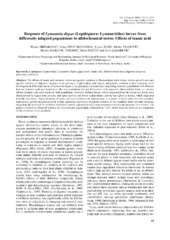Приказ основних података о документу
Response of Lymantria dispar (Lepidoptera: Lymantriidae) larvae from differently adapted populations to allelochemical stress: Effects of tannic acid
| dc.creator | Mrdaković, Marija | |
| dc.creator | Perić Mataruga, Vesna | |
| dc.creator | Ilijin, Larisa | |
| dc.creator | Vlahović, Milena | |
| dc.creator | Janković Tomanić, Milena | |
| dc.creator | Mirčić, Dejan Lj | |
| dc.creator | Lazarević, Jelica | |
| dc.date.accessioned | 2017-11-23T11:12:05Z | |
| dc.date.available | 2015-11-17T10:26:51Z | |
| dc.date.issued | 2013 | sr |
| dc.identifier.issn | 1210-5759 | sr |
| dc.identifier.other | Rad_konverzija_3052 | sr |
| dc.identifier.uri | https://radar.ibiss.bg.ac.rs/handle/123456789/1057 | |
| dc.description.abstract | The effects of tannic acid on mean values and genetic variation in fitness-related traits (mass, relative growth rate) and specific activities of digestive enzymes (total proteases, alpha-glucosidase and lipase), and genetic variation in their plasticity, were investigated in fifth instar larvae of Lymantria dispar L. (Lepidoptera: Lymantriidae) originating from two populations with different host use histories (oak and locust-tree). The two populations did not differentiate with respect to fitness-related traits, i.e. adverse effects of tannic acid were similar in both populations. However, Robinia larvae, which originated from the locust-tree forest, were characterized by higher total protease and lipase activity and lower alpha-glucosidase activity than Quercus larvae, which originated from the oak forest. Higher plasticity of lipase and lower plasticity of alpha-glucosidase in response to tannic acid were also recorded. Quantitative genetic analysis revealed mostly significant expression of genetic variation in the examined traits and trait plasticity, suggesting the potential for evolution of adaptive plastic responses to new environmental conditions and presence of a stressor. The genetic correlations observed between the environments significantly differed from "one", which indicates there are no constraints on the evolution of trait plasticity. | en |
| dc.description.sponsorship | Serbian Ministry of Education and Science [173027] | sr |
| dc.language.iso | English | sr |
| dc.publisher | Czech Academy of Sciences | |
| dc.relation | info:eu-repo/grantAgreement/MESTD/Basic Research (BR or ON)/173027/RS// | |
| dc.rights | openAccess | |
| dc.rights.uri | https://creativecommons.org/licenses/by/4.0/ | |
| dc.source | European Journal of Entomology | sr |
| dc.title | Response of Lymantria dispar (Lepidoptera: Lymantriidae) larvae from differently adapted populations to allelochemical stress: Effects of tannic acid | en |
| dc.type | article | |
| dc.rights.license | BY | |
| dcterms.abstract | Влаховић, Милена С.; Мрдаковић, Марија; Илијин, Лариса A.; Јанковић-Томанић, Милена Ж.; Мирцић, Дејан Љ; Перић-Матаруга, Весна Д.; Лазаревић, Јелица М.; | |
| dc.rights.holder | © 2020 Institute of Entomology | |
| dc.citation.issue | 1 | sr |
| dc.citation.volume | 110 | sr |
| dc.identifier.doi | 10.14411/eje.2013.007 | |
| dc.identifier.scopus | 2-s2.0-84875070935 | |
| dc.identifier.wos | 000318038000007 | |
| dc.citation.spage | 55 | sr |
| dc.citation.epage | 63 | sr |
| dc.type.version | publishedVersion | en |
| dc.identifier.fulltext | https://radar.ibiss.bg.ac.rs/bitstream/id/7519/EJE_eje-201301-0007.pdf | |
| dc.citation.rank | M22 |

